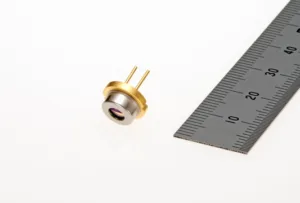Mitsubishi Electric announced a new red laser diode (ML562G85) with a claimed world record output of 2.1W and with 639 nm output and will ship it from 1st February.
Mitsubishi said that the challenge had been to keep the wavelength below 640nm while keeping output high on the device, which emits 4.2 times the amount of light of the current model. The new LED can provide 250 lumens per diode and is claimed to have “wall-plug” efficiency of 41% at the 2.1W output level. The device is packaged in a 9.0mm TO can for improved heat dissipation, and the maximum operating temperature has been raised from 40º to 50º
Analyst Comment
I asked Matt for his comments on this article and this is what he said…
Rec. 2020 colorimetry calls for a laser with a 630nm wavelength. This is not the first example of the difficulty in making solid-state red light sources (LEDs and Lasers) with a short enough wavelength for display applications. Fortunately, the visible color difference between 630nm and 639 nm is small so there will be no problem using this laser in Rec. 2020 applications. The down-side of a 639nm vs 630nm red laser is that the 630nm laser has about 45% more lumens/optical watt than a 639nm laser. Therefore, you must increase the optical power of the 639nm laser by about 45% to get the target brightness and white balance on the screen. This increased optical power for the same brightness has safety implications, although I believe these can be overcome by proper design. Presumably the 639nm laser is significantly more efficient and has a higher lumens/electrical watt than a 630nm laser, which would minimize electrical power consumption. Again, presumably, the difficulty in making 630nm red lasers and the overall lower efficiency of those lasers is why Mitsubishi chose 639nm as a wavelength instead of 630nm.
To color balance the 2.1W of optical power from this diode, you need about 1.3W of green light at 532nm (724 lumens) and 1.2W of blue light at 467nm (60 lumens). This would give a total laser optical power of 4.5W and 1034 lumens. Assuming 50% projector optical efficiency, this would put about 517 lumens on the screen. To make a 30,000 lumen laser cinema projector, one would need about 58 of these laser diodes, or fewer if you could get a projector efficiency better than 50%. This is a doable number since I have seen systems that use this many blue laser diodes so there is no reason why a system couldn’t use this many red laser diodes. – Matt Brenneholtz

